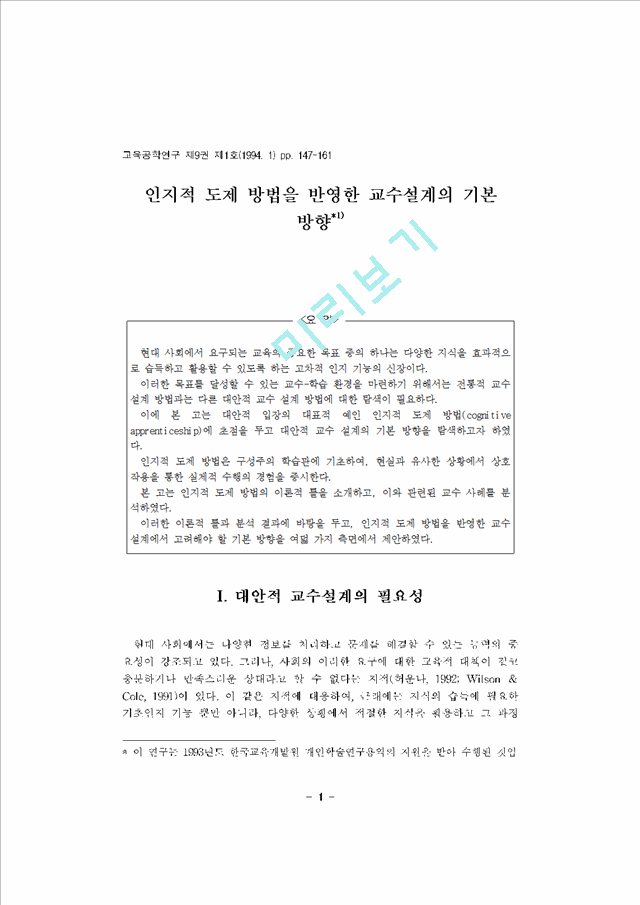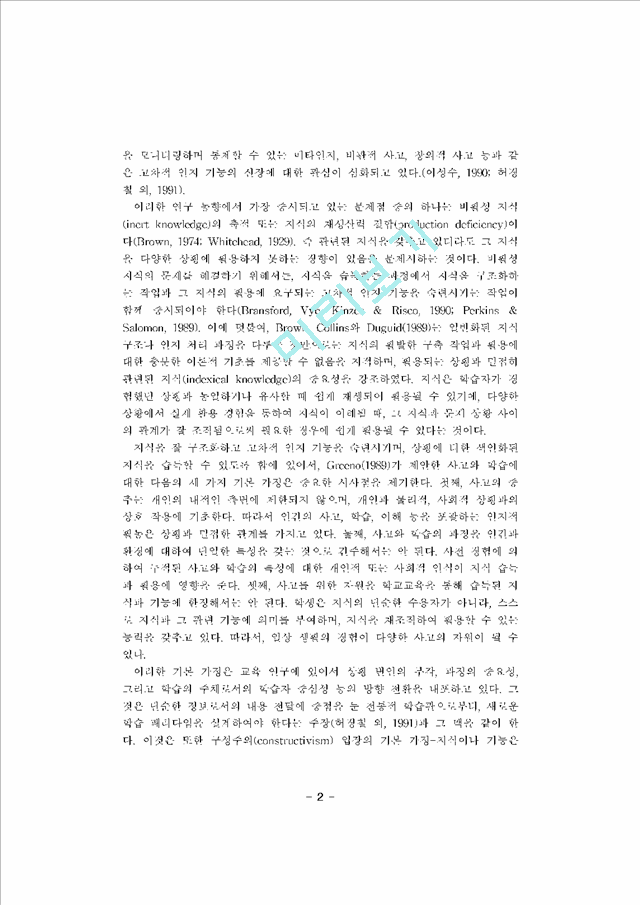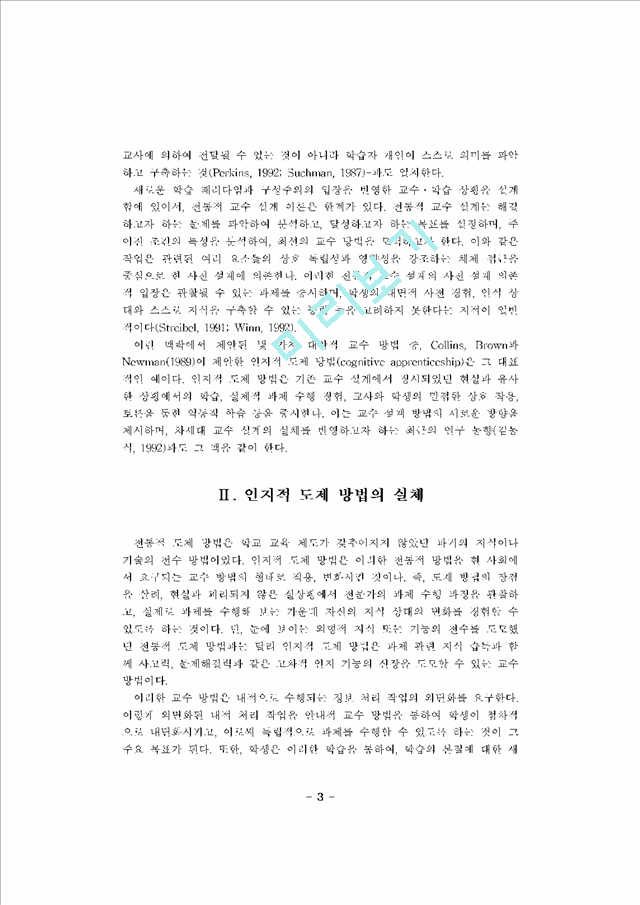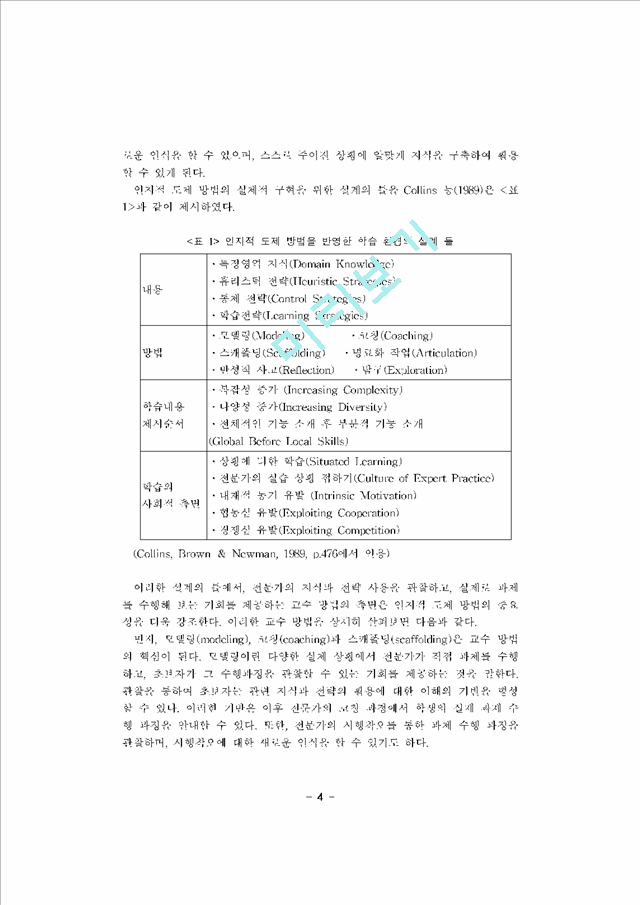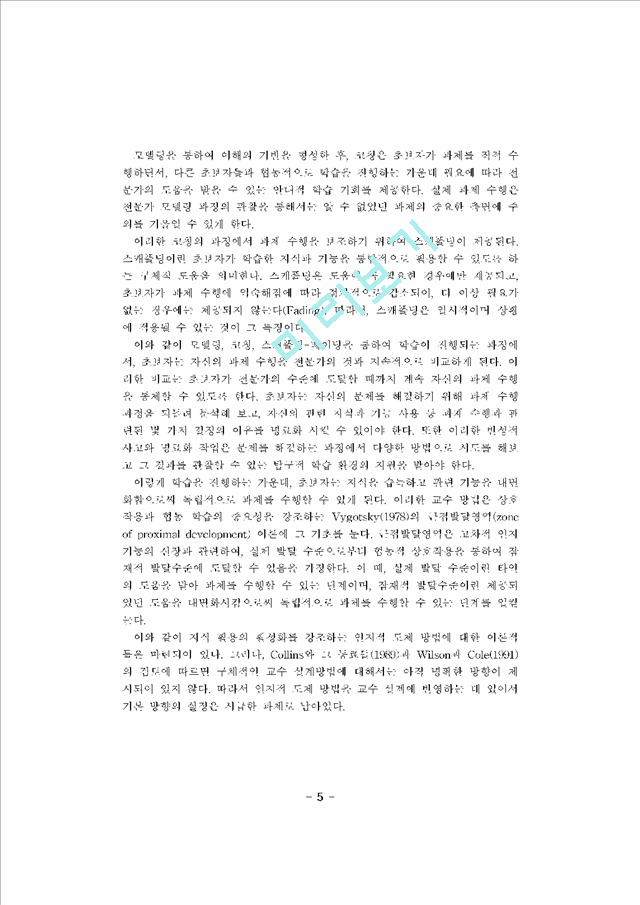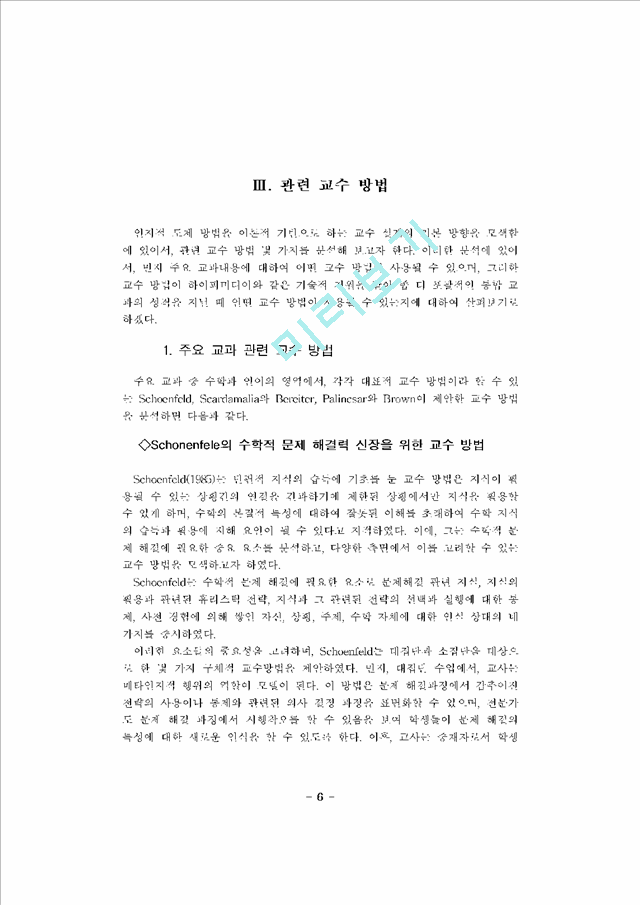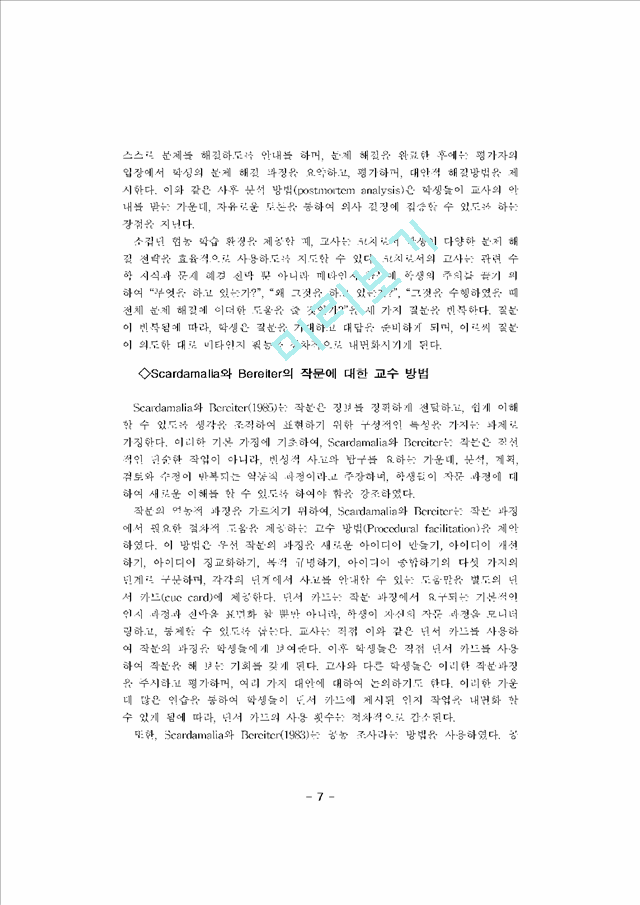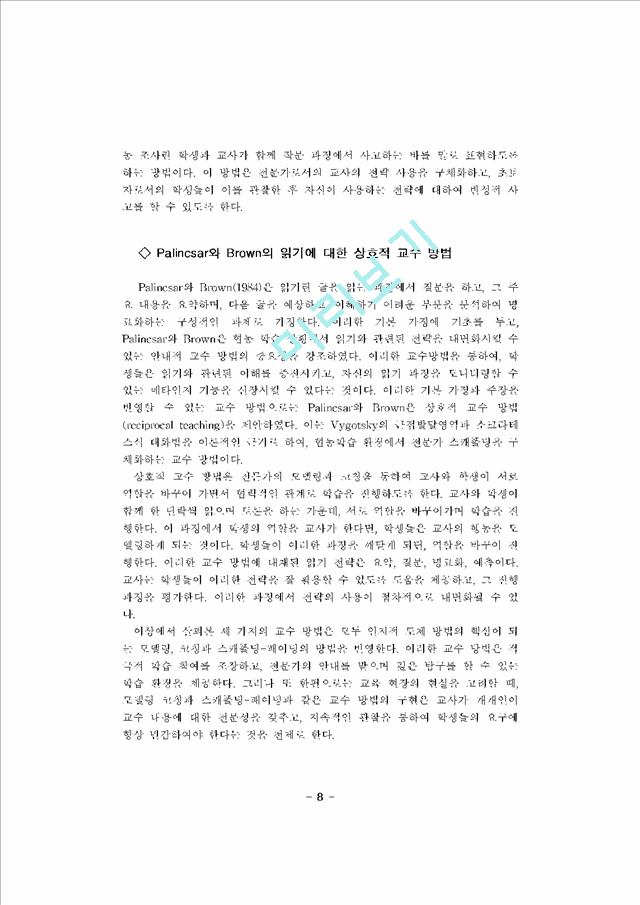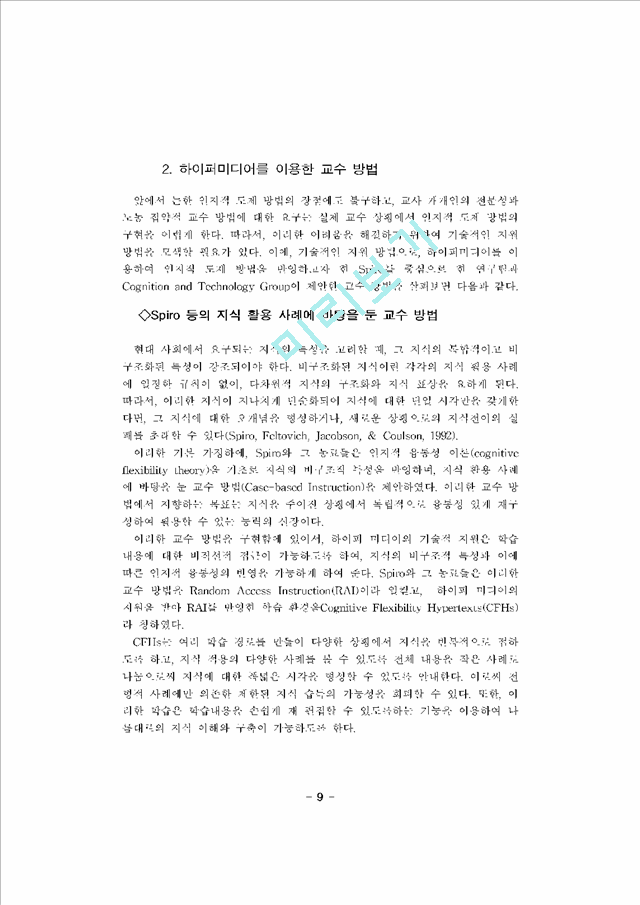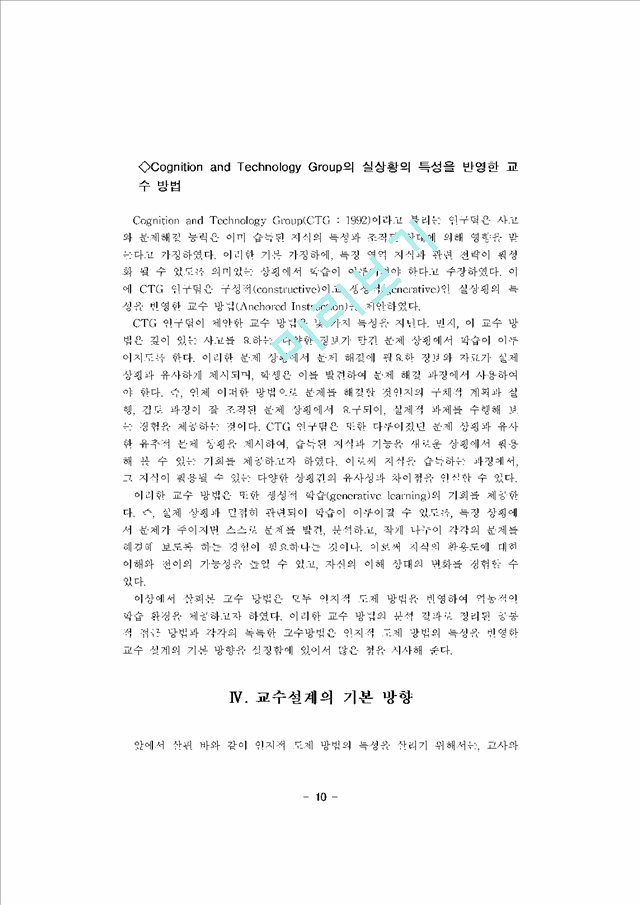|
◇Scardamalia와 Bereiter의 작문에 대한 교수 방법
Scardamalia와 Bereiter(1985)는 작문은 정보를 정확하게 전달하고, 쉽게 이해할 수 있도록 생각을 조직하여 표현하기 위한 구성적인 특성을 가지는 과제로 가정한다. 이러한 기본 가정에 기초하여, Scardamalia와 Bereiter는 작문은 직선적인 단순한 작업이 아니라, 반성적 사고와 탐구를 요하는 가운데, 분석, 계획, 검토와 수정이 반복되는 역동적 과정이라고 주장하며, 학생들이 작문 과정에 대하여 새로운 이해를 할 수 있도록 하여야 함을 강조하였다.
작문의 역동적 과정을 가르치기 위하여, Scardamalia와 Bereiter는 작문 과정에서 필요한 절차적 도움을 제공하는 교수 방법(Procedural facilitation)을 제안하였다. 이 방법은 우선 작문의 과정을 새로운 아이디어 만들기, 아이디어 개선하기, 아이디어 정교화하기, 목적 규명하기, 아이디어 종합하기의 다섯 가지의 단계로 구분하며, 각각의 단계에서 사고를 안내할 수 있는 도움말을 별도의 단서 카드(cue card)에 제공한다. 단서 카드는 작문 과정에서 요구되는 기본적인 인지 과정과 전략을 표면화 할 뿐만 아니라, 학생이 자신의 작문 과정을 모니터링하고, 통제할 수 있도록 돕는다. 교사는 직접 이와 같은 단서 카드를 사용하여 작문의 과정을 학생들에게 보여준다. 이후 학생들은 직접 단서 카드를 사용하여 작문을 해 보는 기회를 갖게 된다. 교사와 다른 학생들은 이러한 작문과정을 주시하고 평가하며, 여러 가지 대안에 대하여 논의하기도 한다. 이러한 가운데 많은 연습을 통하여 학생들이 단서 카드에 제시된 인지 작업을 내면화 할 수 있게 됨에 따라, 단서 카드의 사용 횟수는 점차적으로 감소된다.
또한, Scardamalia와 Bereiter(1983)는 공동 조사라는 방법을 사용하였다. 공동 조사란 학생과 교사가 함께 작문 과정에서 사고하는 바를 말로 표현하도록 하는 방법이다…(생략)
|
김동식(1992)차세대 교수 설계 이론의 기본 논리 및 한계점 탐색. 교육개발. 14(1), 94-103.
이성수(1990), 비판적 사고의 한 측면에 관한 심리학적 접근 -조건적 연역추리는 어디서 ? -. 한국교육, 17. 25-42.
허경철외 4인 (1991). 사고력 신장을 위한 프로그램 개발 연구 (v). 서울 . 한국 교육개발원.
허운나(1992). 미래 학교에서의 첨단 매체 활용 방안, 전국학교컴퓨터교육연구회 세미나 자료집, NASEC SM92-2.
Bransford, J. D., Vye, N., Kinzer, C., & Risko, V. (1990). Teaching Thinking and Content Knowledge: Toward an Integrated Approach. In B.F Jones, & L. Idol (Eds.). Dimensions of Thinking and Cognitive Instruction. Hillsdale, NJ: LEA.
Brown, A. (1980). Metacognitive Development and Reading. In R.J. Spiro et al. (Eds.). Theoretical Issues in reading Comprehension. Hillsdale, NJ: LEA.
Brown, J. S., Collins, A., & Duguid, P. (1989, January). Situated Cognition and the Culture of Learning. Educational Researcher, 32-42.
Cognititilon and Technology Group (1992). Anchored Instruction in Science and Mathematics: Theoretical Basis, Developmental Prokects, and Initial Research Findings. In R. A. Duschl, & R. J. Hamilton (Eds.), Philosophy of Science, Cognitive Psychology, and Educational Theory and Practice, Albany, NY: State University of New York Press.
Collins, A., Brown, J. S., & Newman, S. F. (1989). Cognitive Apprenticeship: Teaching the Crafts of Reading, Writing, and Arithmetic. In L.B. Resnick (Ed.), Knowing, Learning, and Instruction: Essays in the Honor Robert Glaser, Hillsdale, NJ: LEA.
Craik, F. I. M., & Lockhart, R. S. (1972). Levels of Processing: A Framework for Memory Search. Journal of Verbal Learning and Verbal Behavior, 11, 671-684.
Derry, S. J. (1985). Strategy Training: An Incidential Learning Model for CAI. Journal of Instructional Development, 8(2), 16-23.
Glaser, R. (1989). Expertise and Learning. How Do We Think About Instructional Processes Now That We Have Discovered Knowledge Structures? In D. Klahr, & K. KotovskY(Eds.), Complex Information Processing : The Impact of Herbert Simon. Hillsdale, NJ: LEA.
Greeno,J. G. (1989). A Perspective on Thinking. American Psychologist, 44(2), 134-141.
Moll, L. C. (1990). Introduction. In L. C. Moll (Ed.), Vygotsky and Education, New York, NY: Cambridge.
Rigney, J. W. (1980). Cognitive Learning Strategies and Dualities in Information Processing. In R. E. Snow, P Federico, & W. E. Montague (Eds.). Aptitude, Learning and Instruction (vol. 2).Hillsdale, NJ: LEA.
Palincsar, A. S., & Brown, A. L.(1984). Reciprocal Teaching of Comprehension-Fostering and Monitoring Activities. Cognition and Instruction, 1(2), 117-175.
Perkins, D. N. (1992). Technology Meets Constructivism: Do They Make a Marriage? In T. M. Duffy, & D. H. Jonassen (Eds.), Constructivism and the Technology of Instruction: A Conversation. Hillsdale, NJ: LEA.
Perkins, D.N. & Salomon, G. (1989) Are Cognitive Skills Context-Bound? Educational Researcher, 16-25.
Scardamalia, M., & Bereiter, C. (1983), Child as Coinvetigator. Helping Children Gain Insight into their own Mental Processes, In S. G. Paris, G. M. Olson, & H. W. Stevenson (Eds.) Learning and Motivation in the Classroom, Hillsdale, NJ: LEA.
Scardamalia, M., & Bereiter, C. (1985). Fostering the Development of Self-regulation in Children`s Knowledge Processing. In S. F. Chipman, J. W. Segal, & R. Glaser (Eds.). Thinking and Learning Skills` Research and Open & Questions. Hillsdale, NJ: LEA.
SchoenfeId, A. H. (1985) Mathematical Problem Solving. New York, NY: Academic Press, Inc.
Spiro, R. J., Feltovich, P. J., Jacobson, M. J., & Coulson, R. L. (1992). Cognitive Flexibility, Constructivism, and Hypertext. Random Access Instruction for Advanced Knowledge Acquisition in I11-Structured Domains. In T. M. Duffy, & D. H. Jonassen (Eds.). Constrctivism and the Technology of Instruction: A Conuersation. Hillsdale, NJ: LEA.
Stein, B. S., Way, K. R. Benningfield, S. E., & Hedgecough, C. A. (1986). Constraints on Spontaneous Transfer in Problem-Solving Tasks. Memory and Cognition, 14(5), 432-441.
Streibel, M. J. (1991). Instructional Plans and Situated Learning: The Challenge of Suchman`s Theory of Situated Action for Instructional Designers and Instructional Systems. In G. J. Anglin (Ed.), Instructional Technology. Past, present, and Future. Englewood, CO: Libraries Unlimited. Inc.
Suchman, L. A.(1987). Plans and Situated Action. The Problem of Human Machine communication. New York: Cambridge University Press. Vygotsky, L. S. (1978). Mind in Society. the Development of Higher psychological Processes. Cambridge, MA: Harvard University Press.
Wilson. B., & Cole, P. (1991). A Review of Cognitive Teaching Models. ETR&D, 39(4), 47-64.
Winn, W. (1992). The Assumption of Constructivism and Instructional Design. In T. M. Duffy, & D. H. Jonassen (Eds.), Constructivism and the Technology of Instruction: A Conversation. Hillsdale, NJ: LEA.
|
















